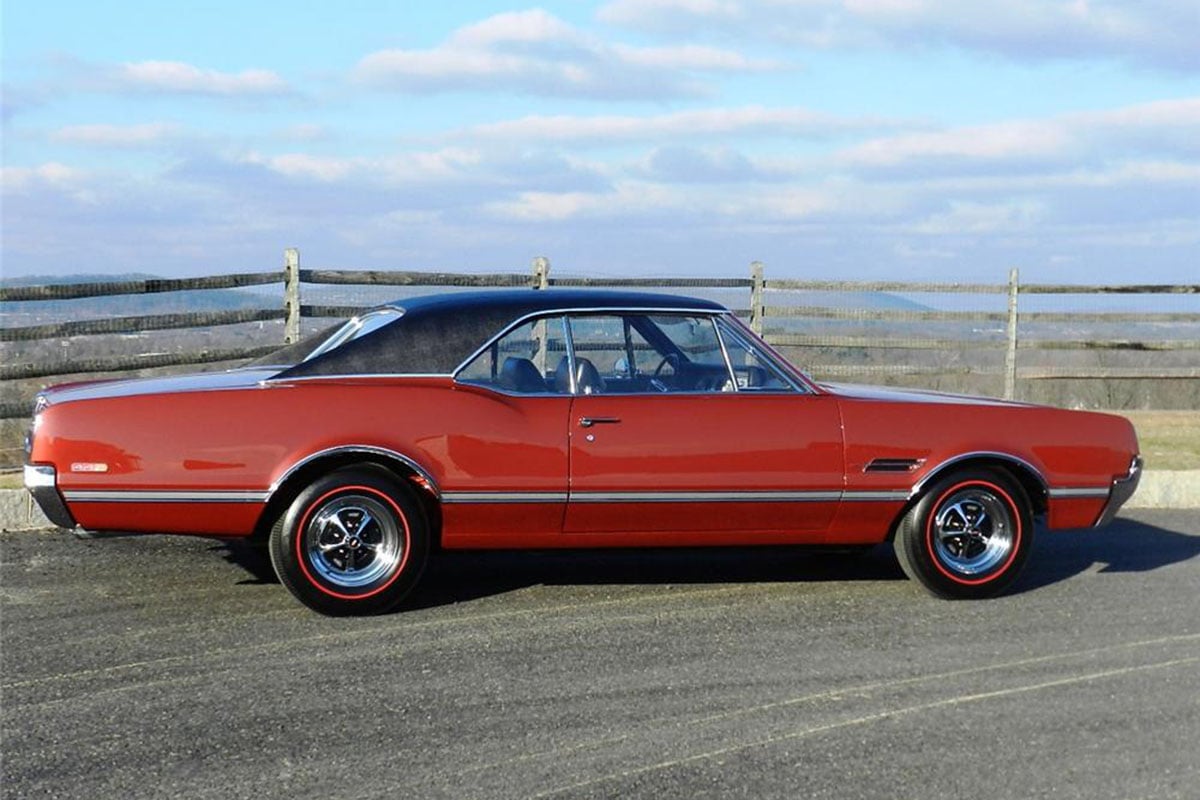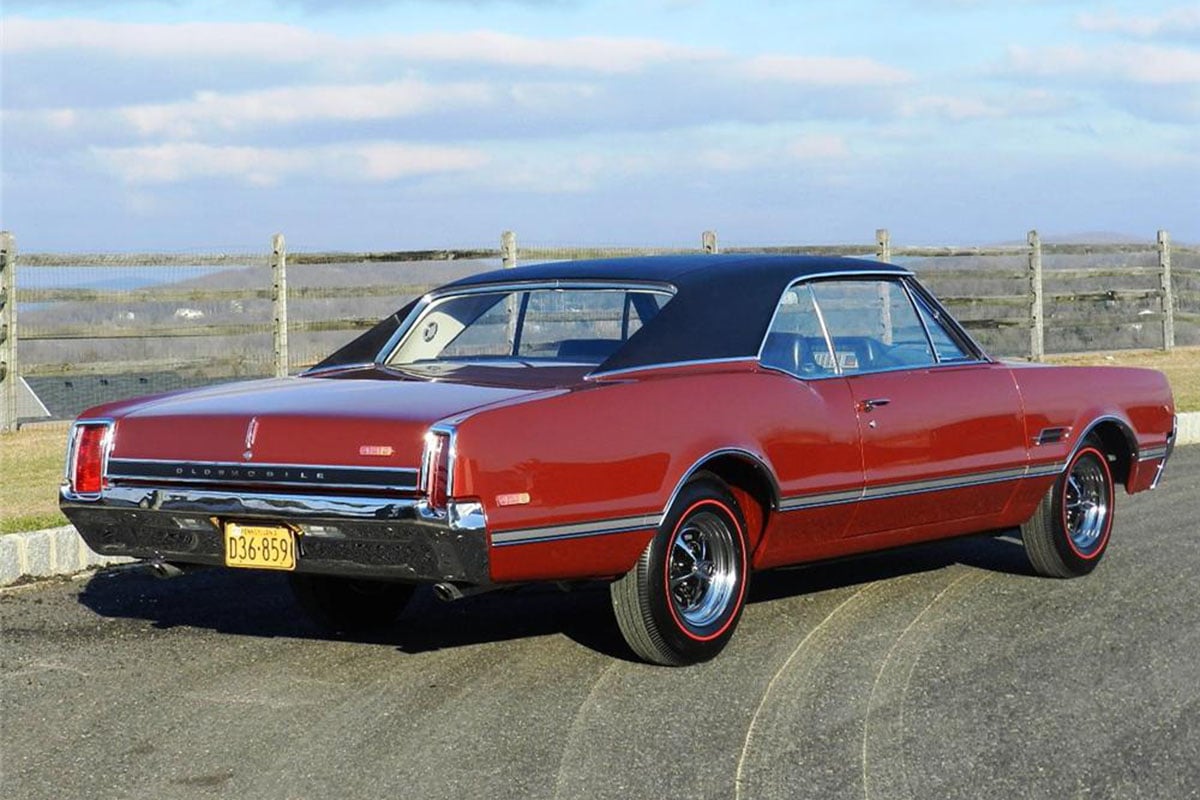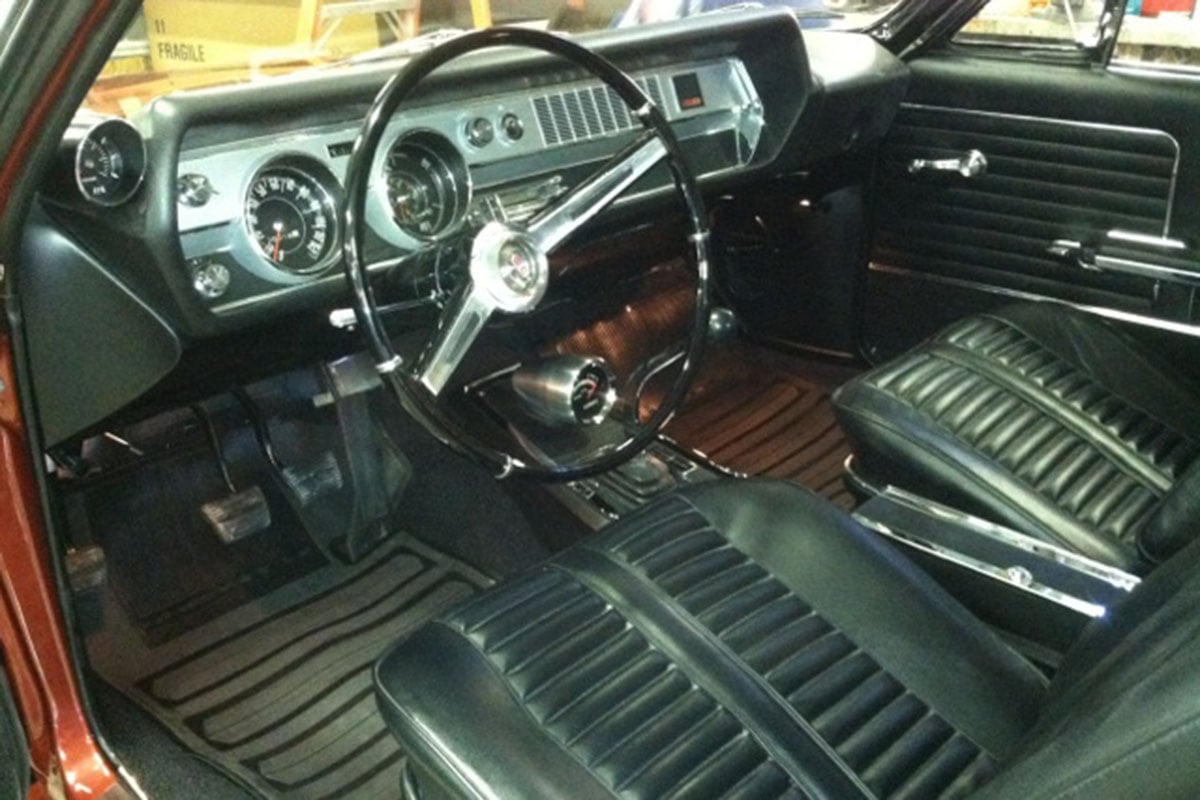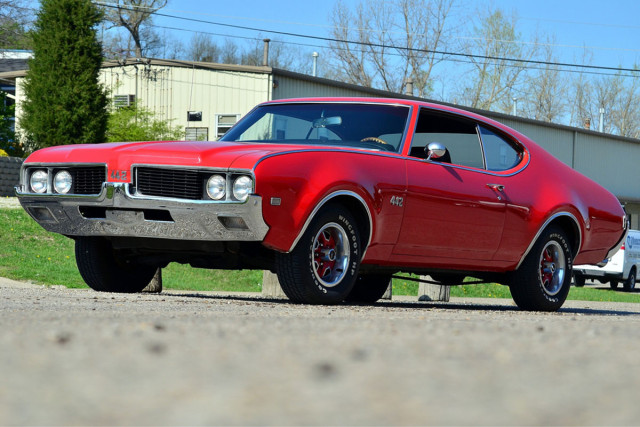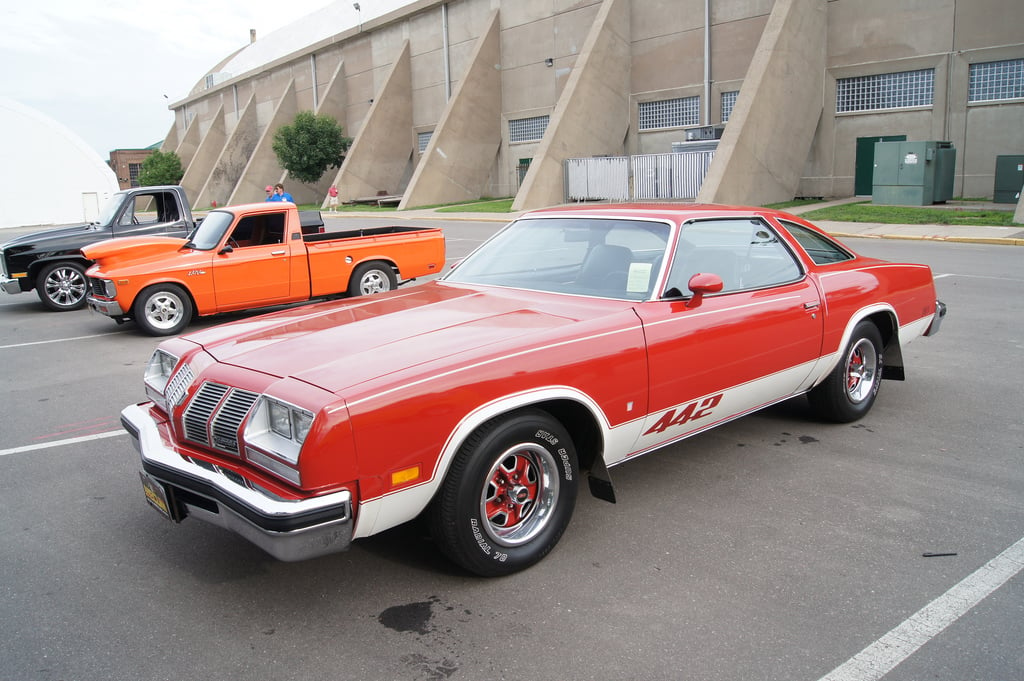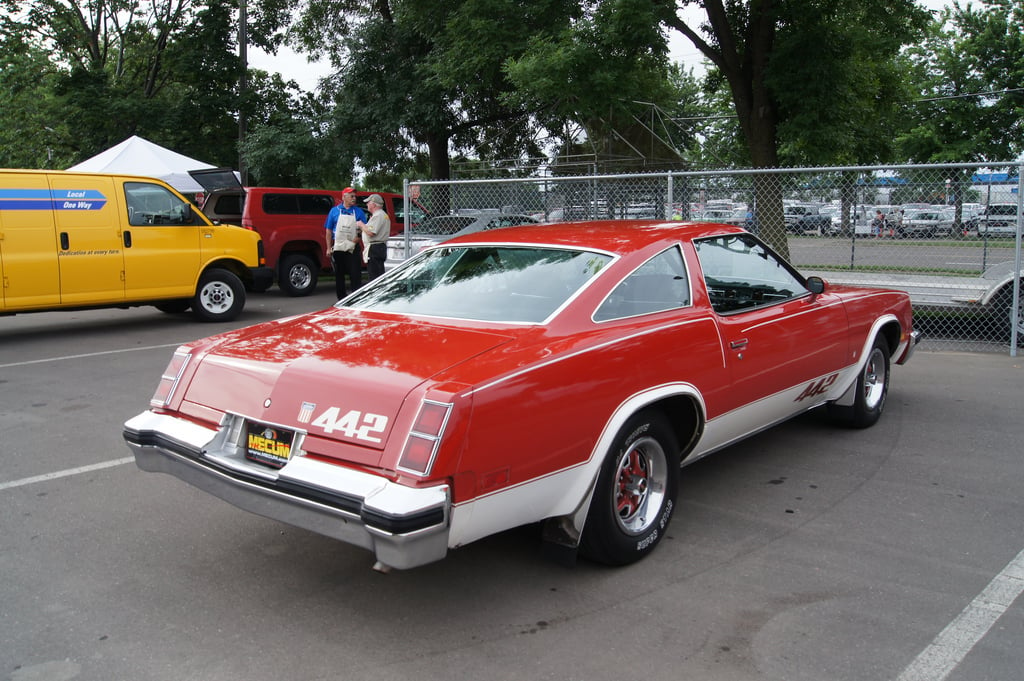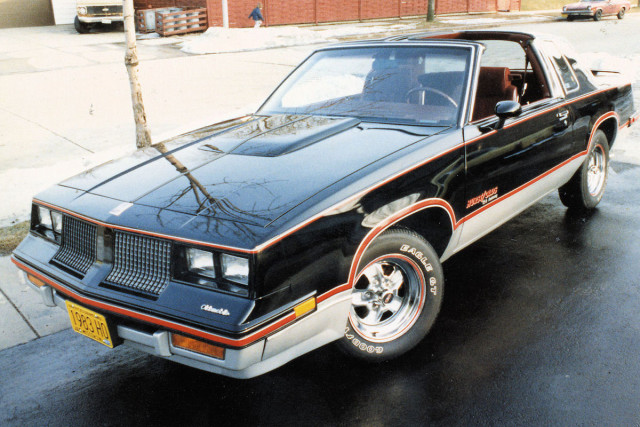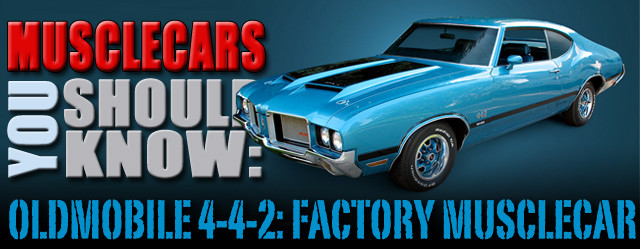 When Pontiac found an unexpected level of success upon releasing the GTO to the motoring public in the middle of 1964, it spawned a power struggle for street supremacy not only among the Big Three, but internally within General Motors as well.
When Pontiac found an unexpected level of success upon releasing the GTO to the motoring public in the middle of 1964, it spawned a power struggle for street supremacy not only among the Big Three, but internally within General Motors as well.
So while the engineers at Chevrolet and Buick scrambled to put together a high output package for their intermediate body coupes, Oldsmobile turned to their own F-85 to give it a similar treatment.
Oldsmobile Joins The Party
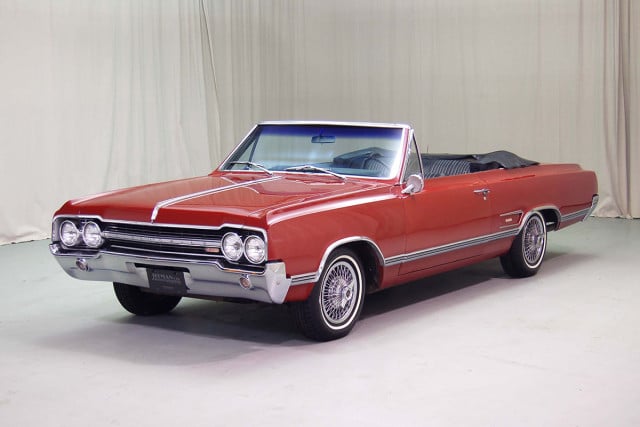
The F-85 might’ve been fairly unassuming in standard trim, but the 442 treatment transformed the car by the second year of its availability. Image: Hagerty
Led by John Beltz – an engineer and performance enthusiast who would later go on to design the Oldsmobile Toronado – the Oldsmobile team quickly put together a performance package for the F-85 in order to get a model on showroom floors for the ’64 model year, which by the time of the GTO’s release was already rapidly coming to a close.
The result of Oldsmobile’s initial efforts was known on the options sheet as the B09 Police Apprehender and Pursuit package, though Oldsmobile’s press release announcing the new model in April of 1964 would be the first time it was referred to as the 4-4-2, which initially stood for four barrel carburetor, four on the floor, and dual exhaust.
The package included Oldsmobile’s 330 cubic inch small-block V8 with a four-barrel carburetor, performance camshaft, and beefed up valve gear that brought the motor’s output put to a respectable 310 horsepower and 355 lb-ft of torque. A four-speed Muncie manual gearbox was the only transmission initially available with the 442 package for 1964, as the warmed over small block proved to be too much for the Jetaway automatic transmission Oldsmobile was using at the time.
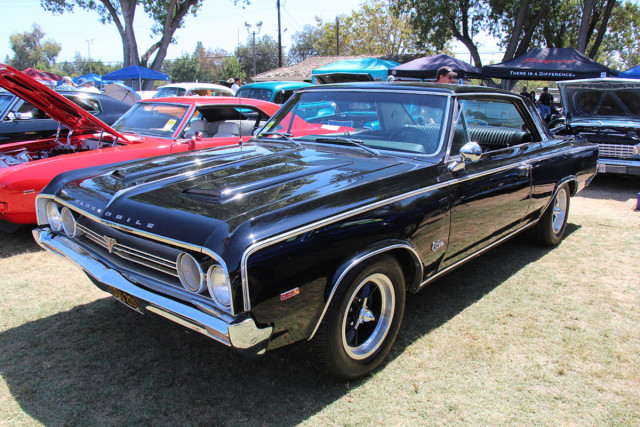
The sudden popularity of Pontiac’s GTO had Oldsmobile engineers rushing to put out a similar offering the same year.
Along with the high performance drivetrain, the 442 got an upgrated brake package, frame stiffening, heavy duty suspension from the police package, and a dual snorkel air cleaner. Priced at $285.14 – or about ten percent of the Cutlass’s base price – the 442 (or B09) package could be added to any F-85-model aside from the station wagon. Oldsmobile archives indicate that approximately 10 four-door sedans were built with the B09 option, and a vast majority of buyers who checked the box for the performance package applied it to Cutlass coupes.
While it was a promising start and Oldsmobile went on to sell nearly 3,000 examples of the 442 in its initial year, the following year would see the 442 truly begin to hit its stride.
A True Contender
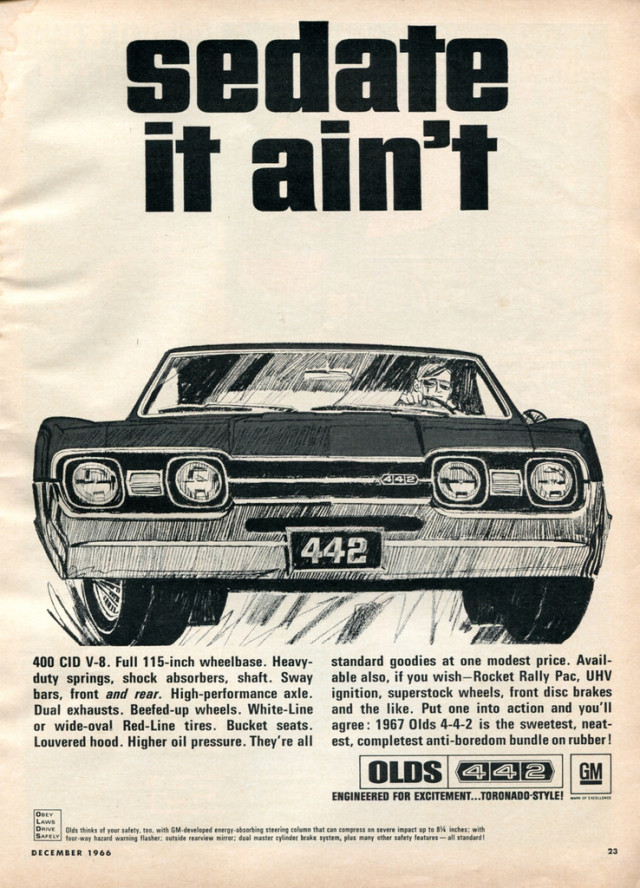 During the 1960s, GM had a number of odd corporate policies – one of which stated that intermediate bodied vehicles could not use V8s larger than 330 cubes. Speculation is that this was a way to prevent the cheaper models from eclipsing the Corvette as GM’s halo performance model, but once the GTO hit showrooms sporting a 389ci V8, all bets were off.
During the 1960s, GM had a number of odd corporate policies – one of which stated that intermediate bodied vehicles could not use V8s larger than 330 cubes. Speculation is that this was a way to prevent the cheaper models from eclipsing the Corvette as GM’s halo performance model, but once the GTO hit showrooms sporting a 389ci V8, all bets were off.
Accordingly, for the 1965 model year Oldsmobile shoehorned a new 400 cubic inch V8 into the engine bay that sported an output of 345 horsepower and a stump-pulling 440 lb-ft of torque. A trio of new transmission options would also join the four speed Muncie, now including a beefed up version of the Jetaway two-speed automatic as well as a column-mounted three-speed manual and a heavy duty three-speed manual featuring a Hurst performance shifter, leading Oldsmobile to adopt a new meaning for the 442’s name: 400 cubes, four barrel carburetor, and dual exhaust.
The 1966 model refresh would see the Cutlass/442 come into its own stylistically. Image: Barrett-Jackson
Performance increased dramatically, with the 1965 442 getting from zero to sixty miles per hour more than a second faster than the previous model year, according tests conducted by Motor Trend on the ’64 and Car and Driver on the ’65, making the 442 one of the most capable muscle cars available at the time.
The following year would see a styling facelift applied to all F-85 models, but for the 442, the biggest news was under the hood. That year would see the introduction of two new engine options – the L69, which was rated at 360 horsepower and 440 lb-ft by way of a triple two-barrel Rochester carb setup, and the soon-to-be legendary W30.

As the old saying goes, there’s no replacement for displacement. By 1967 the 442 packed a 400 cubic inch power plant that gave Oldsmobile owners the firepower to go toe-to-toe with the best Detroit had to offer. Image: Barrett-Jackson
The W30 package added a cold air induction system that ran through the front bumper and directly to the carburetor and featured a hotter camshaft profile, along with a few other minor tweaks versus the standard engine offering. W30 models also had the battery relocated to the trunk in order to make room for the cold air system’s ducting.
Although the W30 motor was listed with the same 360 horsepower as the L69, many Oldsmobile aficionados speculate that the motor was seriously underrated.
1966 would also mark the first year that Hurst shifters became standard equipment on all 442s with floor mounted shifters on manual gearboxes. With the one-year introduction of the triple carburetor setup on the L69 engine option, the meaning of the 442 moniker got even murkier, but by now enthusiasts already knew that the 442 badge simply meant serious Oldsmobile performance.
A New Model For A New Generation
By 1968 the 442 option had gotten popular enough that when the second generation car debuted, the 442 became its own standalone model. Following suit with its platform-mate from Chevrolet, the Chevelle, the 442 adopted a new, more stylized coke-bottle design to go along with an ever-increasing focus on performance.
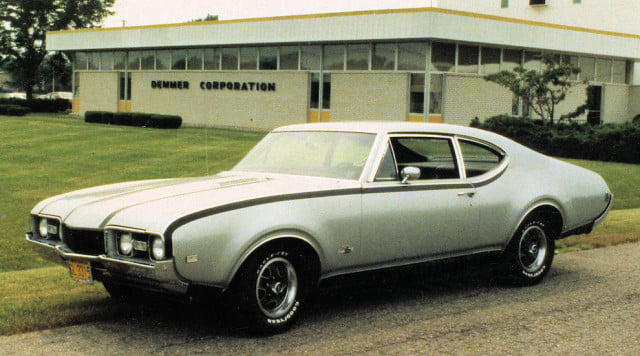
By 1968, Oldsmobile’s partnership with Hurst Performance had resulted in an entirely new options package for the 442, yielding some seriously formidable performance capability for the second generation muscle car.
To that end, that year would spawn the first joint project between Oldsmobile and Hurst Performance. The resulting Hurst/Olds treatment proved to be a far more comprehensive package than just the shifters that the 442 had used in the past.
Painted Peruvian Silver with black and white accent stripes, the Hurst/Olds 442 featured a number of both cosmetic and mechanical upgrades, including a 455 cubic inch big block V8 rated at 390 horsepower and 500 pound-feet of torque that could propel the 442 into the high 13 second range in the quarter mile right off the showroom floor.
Numerous upgrades that were normally optional on the 442 were standard on the Hurst/Olds package, like FE2 performance suspension, disc brakes, and heavy duty cooling.
Third Generation Ushers In A Different Era
Like the majority of new muscle cars at the time, when next generation 442 debuted in 1973, it brought with it the sweeping changes that were affecting the auto industry as a whole, most notably in terms of performance and style.
New government safety standards dictated much of the 442’s external design, including its energy absorbing bumpers and a B-pillar reinforced roof. Additionally, performance numbers that had dropped precipitously from just a few years prior, were due mainly to concerns over both emissions and fuel economy, as well as the industry’s confusing transition over to the SAE Net horsepower rating system.
Even the venerable 442 wasn't immune from the pitfalls that befell the entire performance industry during the mid-to-late 70s. Performance was way down from the early part of the decade, but the 442 remained a compelling option for would-be enthusiasts looking for something more than the standard Cutlass.
The 442 would soldier on nobly throughout a dark period in domestic performance, including a fourth generation transition to a hatchback layout based on the A-body Cutlass platform in 1978.
Debuting in 1985, the fifth generation 442 would see the model return to its coupe roots when it was moved to the G-body platform shared with the Buick Regal and Chevrolet Monte Carlo.
Powered by a 5.0-liter V8, performance was still a far cry from the first and second generation cars with an output to 170 horsepower and 250 lb-ft of torque, but with the enthusiasts starving for new performance machines, Oldsmobile continued to sell enough examples of the 442 to justify continuing production of the iconic model.
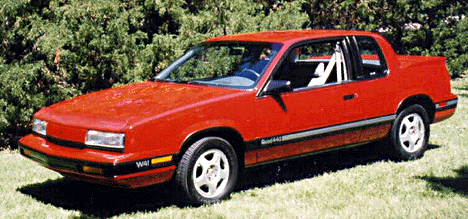
The sixth-generation 442 may have shared little with its heritage, but it still offered a more dynamic driving experience than the standard Cutlass in an era where domestic performance options were few and far between.
While the 442 would sit out the 1988 and 1989 model years, Oldsmobile would revive the model for 1990, applying the badge to the now front-wheel-drive Cutlass Calais. Powered by the LG0 four-cylinder motor making 180 horsepower, which was mated to a 5-speed manual transmission, the sixth generation 442 would only last two model years before Oldsmobile finally put the performance badge to rest.
Although the 442’s legacy didn’t end at the pinnacle of its game, the moniker has remained a household name synonymous with domestic performance, despite the fact that Oldsmobile has ceased to exist as a brand for more than a decade.




